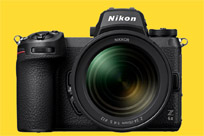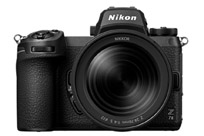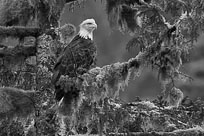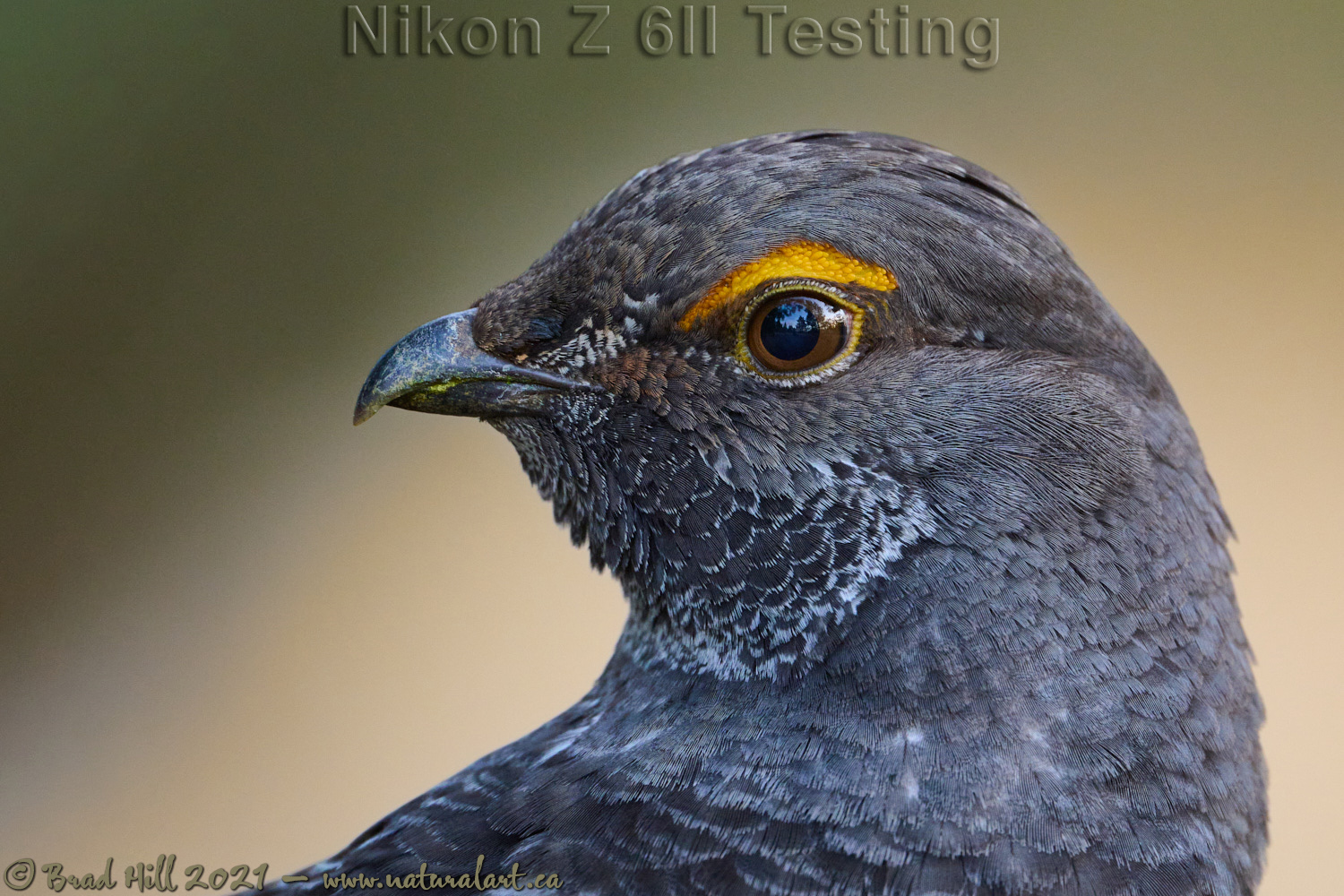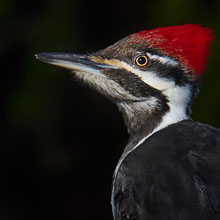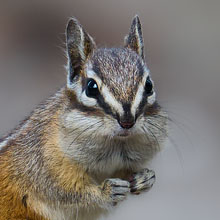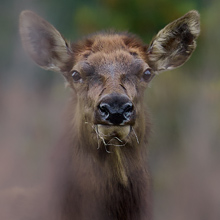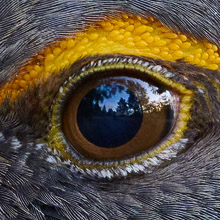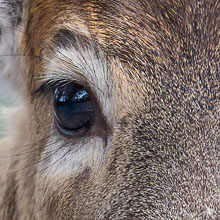Availability: Undetermined - Enquiries?
In the Field
Z 6II Testing - First Hooter of Spring 2021. Findlay Creek Region (East Kootenays), British Columbia, Canada. April 7, 2021.
This is my fourth gallery post and commentary conveying my experiences with shooting wildlife using the Nikon Z 6II. In this case the subject is portrait/profile shot of a male Dusky Grouse captured very early in the morning near my home in the East Kootenays of BC. In our neck of the woods Dusky Grouse are altitudinal migrants that spend the winters in the high alpine, and then descend to lower elevations to breed, raise their young, and generally hang out until mid-autumn. This male was the first one to show himself on our property in 2021, and he was already doing what male Dusky's pre-occupy themselves with in the spring - hooting (and hooting, and hooting) to attract a female to mate with. In this particular case the grouse was probably disappointed that all his hooting attracted was a pesky photographer! ;-)
There are at least two things about this image that shed some light on the utility of the Z 6II as a camera for shooting wildlife. First, and as mentioned above, this image was shot early in the morning - it was still before the sun had risen above the mountains around me (tho' you can see in the reflection of the grouse's eye that the sky was already a nice blue color). I shot this image "wide open" with the lens/TC combo I was using, but in this case "wide open" isn't very wide (f11!). So...I had no choice but to use a fairly high ISO to capture the image - in this case ISO 6400. During processing I did nothing special at all to kill noise - I simply used the default (or "automatic") noise reduction of Capture One. And, as you can see, the end result was pretty good, and certainly "clean enough" (from a noise perspective) for most uses. With my style of wildlife shooting (which includes hand-holding a lot of my super-telephoto lenses) and the dark locations I often work in, excellent high ISO performance is a real critical part of what I look for in a wildlife camera. And, in probably 90% or more of my shooting situations, the Z 6II will satisfy my need for excellent high ISO performance. In those rare situations where I need even better ISO performance I'll be turning to my D6.
Second, I am becoming increasing thrilled about what I consider a completely unexpected bonus of transitioning to shooting Nikon mirrorless cameras - unprecedented performance of teleconverters (including when using adapted f-mount lenses and f-mount teleconverters). And, I am finding that this is the case with BOTH the Z 7II and Z 6II. This image was captured with a 500mm f5.6E PF lens paired with the TC-20EIII (2x) teleconverter, and it was hand-held at 1/80s. And, I took about 20 other shots at the time - and almost all of them were this sharp (tho' in many of them I captured a half-closed eye or the angle of the bird's head was such that the shallow DoF lead to an ugly result!). But...if I was shooting any Nikon DSLR (including a D6) the odds of me being able to capture this image with the same lens/TC combo would have been almost zero.
Why? Well, to begin with, NO Nikon DSLR would have been able to focus on the bird with its AF system - simply put, a lens/TC combo with a maximum aperture of f11 isn't "compatible" with a DSLR's AF system (and the camera won't focus, except if you use manual focus). But even if I made this shot with the same lens paired with the TC-14EIII (1.4x) teleconverter the AF system would be at its limit (even with a D6 only a little over 10% of its AF points work with lens/TC combos of f8) and quite impaired. And my own experience is that when using the 500 PF with a 1.4x TC on a D5 or D6 the hit rate of sharp shots is pretty low...to the point where I was extremely hesitant to shoot that lens/TC combo. Yet with both my Z 6II and Z 7II I get really high hit rates when shooting the 500 PF with both the 1.4x and 2x TC's...and the resulting shots are really, really sharp.
Note that I have found this same trend when shooting TC's with other high-end Nikkor super-telephoto primes or zoom lenses on my Z-cameras. This includes when using combinations like the 180-400 plus the TC-20EIII (2X) teleconverter, when using the 180-400 with its built-in TC PLUS the TC-14EIII (1.4x) teleconverter (i.e., a 1.4x TC stack), and when using the 120-300mm f2.8E with either the TC-14EIII or the TC-20EIII.
Why the big bump in TC performance when using Nikon mirrorless vs. Nikon DSLR bodies? I can't say for sure, but I strongly suspect it's simply due to the different "mechanics" of how the AF systems work. Not only are the AF sensors of the mirrorless bodies receiving much more light than those of the "proxy" RGB sensors where the AF sensors are on a DSLR (which removes the constraint of needing a maximum aperture of f8 or larger), but the fact that with mirrorless you are focusing directly on the SAME sensor where the image is captured. So any issues associated with violating the tight tolerances needed by a DSLR focusing system (via adding a TC) are functionally negated simply by how the AF works on a mirrorless camera.
Now, to be clear, I'm NOT saying that you always get crappy results when shooting TC's with any and all lenses when using a Nikon DSLR. In fact, there were a select few lenses where I would regularly add a 1.4x TC and occasionally even a 2x TC. Such as the 400mm f2.8E - I found this lens worked really well with a 1.4x TC, and could often produce very good results with a 2x TC (tho' the hit rate of this combination did fall quite a bit compared to the hit rate of the same lens used with the 1.4x TC). What I am saying is that the overall performance and usability of BOTH the 1.4x and 2x TC are much BETTER with the newest Zed bodies. In my case I have gone from being a reluctant and cautious TC user to one who doesn't even hesitate to add a TC to my super-telephotos if I have a Zed camera in my hands! And that is a completely unexpected (and very welcomed) benefit of my transition to mirrorless!
Here's a larger version (2400 pixel) of this tightly framed hooter:
• First Hooter of Spring 2021: Download 2400 pixel image (JPEG: 1.7 MB)
ADDITIONAL NOTES:
1. This image - in all resolutions - is protected by copyright. I'm fine with personal uses of them (including use as desktop backgrounds or screensavers on your own computer), but unauthorized commercial use of the image is prohibited by law. Thanks in advance for respecting my copyright!
2. Like all photographs on this website, this image was captured following the strict ethical guidelines described in The Wildlife FIRST! Principles of Photographer Conduct. I encourage all wildlife photographers to always put the welfare of their subjects above the value of their photographs.
Behind the Camera
Z 6II Testing - First Hooter of Spring 2021. Findlay Creek Region (East Kootenays), British Columbia, Canada. April 7, 2021.
Compressed RAW (NEF) 14-bit format; ISO 6400.
Nikon Z 6II paired with Nikkor 500mm f5.6E PF plus TC-20EIII (2x) teleconverter (for a total focal length of 1000mm). Hand-held. VR on and in Normal mode. Single Point Area AF area mode. Silent photography mode "on" (full electronic shutter used).
1/80s @ f11; no compensation from matrix-metered exposure setting.
At the Computer
Z 6II Testing - First Hooter of Spring 2021. Findlay Creek Region (East Kootenays), British Columbia, Canada. April 7, 2021.
RAW Conversion to 16-bit PSD file (and JPEG files for web use), including all global and selective adjustments, using Phase One's Capture One Pro 21. No global adjustments were made to this image. Selective local adjustments performed using Capture One Pro's layers and masking tools. In this case selective adjustments were made on 8 separate layers and included one or more tweaks to color (using the Color Balance tool), exposure, clarity, shadows, and sharpness.
Photoshop modifications were limited to the insertion of the watermark and/or text.
Conservation
Z 6II Testing - First Hooter of Spring 2021. Findlay Creek Region (East Kootenays), British Columbia, Canada. April 7, 2021.
Species Status in Canada*: This species is not designated as at risk.
Until recently the Blue Grouse (Dendragapus obscurus) was considered a single species with at least two sub-species. However, mitochondrial DNA sequence data, combined with older behavioural and distributional data, has resulted in the decision to split the species into two species - Sooty Grouse (coastal), and Dusky Grouse (found in the interior).
Dusky and Sooty Grouse are endemic to mountainous regions of western North America and both have geographic ranges restricted to moderate to high altitude regions. Many populations undergo an altitudinal migration, spending winters in conifer forests at higher elevations and then descending to lower elevations and more open terrain to breed in the spring. During breeding the males perform a dramatic dance and produce repetitive low-frequency vocalizations (hoots) to attract females to their breeding territories.
*as determined by COSEWIC: The Committee on the Status of Endangered Wildlife in Canada







